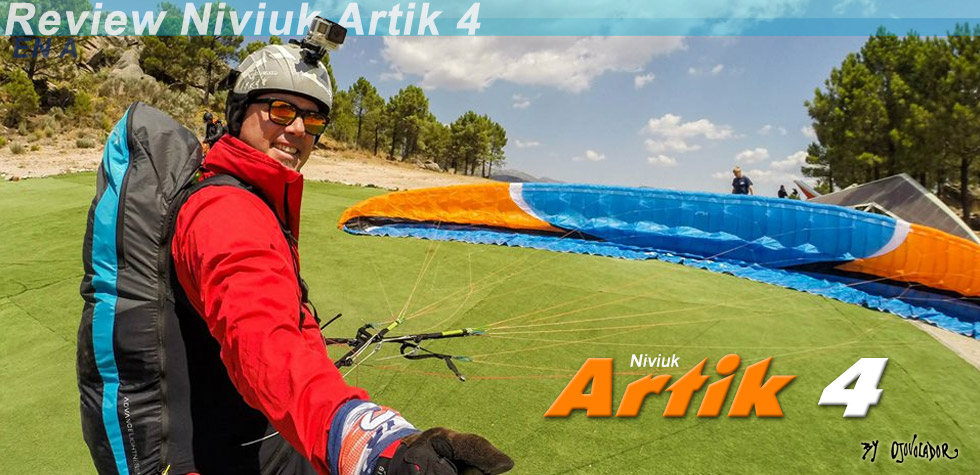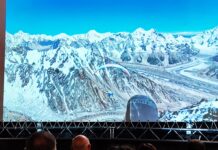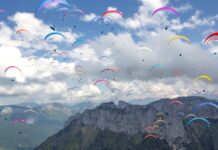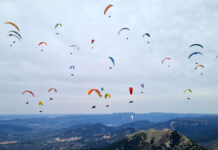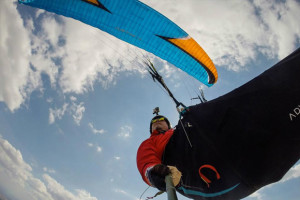 The EN C model of the Spanish manufacturer Niviuk, the Artik 4, targets a broad segment of pilots as it is a very accessible intermediate glider that boasts top performance, which makes it a good climbing and XC machine.
The EN C model of the Spanish manufacturer Niviuk, the Artik 4, targets a broad segment of pilots as it is a very accessible intermediate glider that boasts top performance, which makes it a good climbing and XC machine.
With aspect ratio of 6.1 and 63 cells, the new Artik incorporates leading edge with Ram Air intakes as well as the customary rods, and in its construction -with lines of different diameters and combining Porcher and Dominico fabrics– they managed to reduce the total weight of the glider (5.6 kg for the size 27 we tested).
The handling of the Artik 4 can be very docile or sportive; it is easy to understand and to get what you want. It is also a compact and collapse-resistant wing with which you can feel confident while you fly away enjoying its performance. That is what we confirmed in our special test flight: a +160 km cross country flight, of which we’ll tell you more below.
Pedro Bernardo – Riaza
Since the start of the 2015 season we were awaiting Niviuk’s sport glider and, finally, by the end of August we received a brand-new demo Artik 4. We had already flown next to other pilots on this glider, appreciated its details and its advanced performance, and now it was time to check it by ourselves. For that purpose I met up with Miguel Sanchez, a mate with whom I had done a good XC flight in previous days. Miguel was my tandem passenger about 5 years ago and the flying bug bit him: shortly after, he took a paragliding course, and after progressing through two gliders – the last, a Mentor 2 with which he had done a number of +100 km flights-, this season he changed to an Artik 4. Miguel flies over 150 hours a year and represents a very close profile of the pilot this paraglider is intended for.
The forecasts were favorable to try a declared goal to Riaza (Segovia). We designed our route thoroughly, studying the pass over the Gredos mountain range from the Tietar Valley to Avila, where we had a “corridor” to continue the flight dodging the Madrid CTR and also the LEP 61 (Police school in Avila).
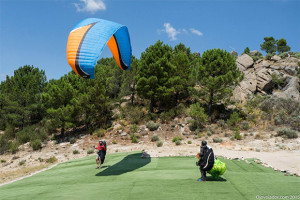 We took off from Pedro Bernardo at 13:45h. At the beginning there was not a defined wind direction, but at about 1800m we found a gentle but definite layer of wind of about 10 km/h. There was a lot of turbulence at times, however, I could handle the situation pretty well because this Artik dampens the bumps and in turbulent air it responds smoothly. Miguel, with a little less “hand” and experience, took his first big collapse – but the reopening was quick and well-natured. We went on along the mountain range to Mijares, where we took a climb to the first 3000m base of the day. From there we followed a line of clouds that took us to the Gredos peaks to then cross in direction to El Barraco to the north, shortly before Piedralaves.
We took off from Pedro Bernardo at 13:45h. At the beginning there was not a defined wind direction, but at about 1800m we found a gentle but definite layer of wind of about 10 km/h. There was a lot of turbulence at times, however, I could handle the situation pretty well because this Artik dampens the bumps and in turbulent air it responds smoothly. Miguel, with a little less “hand” and experience, took his first big collapse – but the reopening was quick and well-natured. We went on along the mountain range to Mijares, where we took a climb to the first 3000m base of the day. From there we followed a line of clouds that took us to the Gredos peaks to then cross in direction to El Barraco to the north, shortly before Piedralaves.
Sporty and solid
According to our analysis with XCSky, this was the most difficult area of the day with the lowest thermal potential. We arrived with altitude and, even though it wasn’t so bad, Miguel 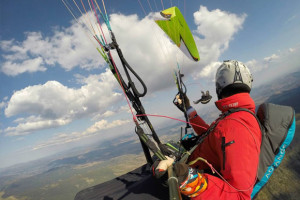 had his lowest point and had to work hard on the slopes of El Barraco, until he could join me again. Then, we climbed up to 3,400 m in one of the best thermals of the day, “coiling” a wonderful core that kept on getting better and better. There I could appreciate the solidity of the Artik 4 and how it traces the turns with joy and determination. Turbulence does not affect it much, and the only thing that I would adjust it to my personal taste would be the length of the brakes to about 3-4 cm shorter than the standard.
had his lowest point and had to work hard on the slopes of El Barraco, until he could join me again. Then, we climbed up to 3,400 m in one of the best thermals of the day, “coiling” a wonderful core that kept on getting better and better. There I could appreciate the solidity of the Artik 4 and how it traces the turns with joy and determination. Turbulence does not affect it much, and the only thing that I would adjust it to my personal taste would be the length of the brakes to about 3-4 cm shorter than the standard.
Then a cloud street drew a highway to Avila for us, to the North. It was the easiest part of the flight, with thermals of continuous +5 m/s with which we reached the top base of the day at 3,800 m. I was navigating with half pedal and correcting with the C risers in a fast and efficient glide.

But as all good things come to an end, the clouds died out ahead and we were forced to turn to the West to follow the classic route over the N-110 road towards Villacastin and Segovia. After three good thermals we were in Segovia, but there I took a bad line and was poorly positioned on a rocky slope. After several minutes turning in zeros, below me appeared a dozen of Griffon Vultures that followed a ridge and then opened to the Valley.
I quickly joined them and with the “support” of the gaggle I could take advantage of a drifted thermal that put me back in a flight that had taken us for over 120 km, and still had a couple of hours ahead. Miguel, who passed higher and went away easily, lost sight of me and figured
I would have landed on the slope.
While he went around Navafria, I passed it almost on the vertical and quickly caught up with him to resume the flight together. A convergence of book had us strolling along the range. We flew over the Arcones takeoff and were gradually losing height until Somosierra, where we had to climb back almost from the power lines that went down the highway
Floater
It was already 7:30pm and possibly this would be our last good thermal, the glide would give us nearly 10 Km but there were 20km to Riaza, our goal… And now we also had face wind. 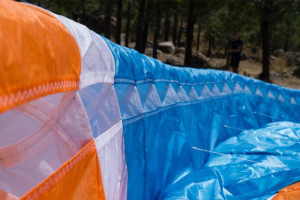 Anyway, we went on turning the slightest lift never losing the hope of finding something more that could allow us to complete our goal. I bear witness of the good qualities of the Artik 4 to climb even in the mildest thermals. At 2800m, when that last thermal did not offer anything more, I started my final glide. Miguel was about 200m below and shortly after he went on too. The last was a “floaty” section; I advanced slowly losing very little height, in face wind but with good sink rate. I was not going to make it to Riaza by glide, besides, there was a large forest before the first landable meadows.
Anyway, we went on turning the slightest lift never losing the hope of finding something more that could allow us to complete our goal. I bear witness of the good qualities of the Artik 4 to climb even in the mildest thermals. At 2800m, when that last thermal did not offer anything more, I started my final glide. Miguel was about 200m below and shortly after he went on too. The last was a “floaty” section; I advanced slowly losing very little height, in face wind but with good sink rate. I was not going to make it to Riaza by glide, besides, there was a large forest before the first landable meadows.
The glide ratio was surprisingly good and I also stopped to turn a couple of times. Finally, I set myself in aerodynamic mode and continued straight towards Riaza. I passed the wood and even advanced a couple of km more to land at 20:06 on a huge field.
Preparation for flight and equipment: The flight lasted 6h10m. I ate 4 energy bars and drank half a liter of water. My instruments were a Flymaster Live and a Flytec Connect 1. I flew with my light and compact harness Advance Lightness 2, which allowed me to be close to the weight range. I wore shorts, but the fairing kept me warm. On the top, over a t-shirt, I put on a thermal long sleeve shirt and a very light and effective Skywalk technical windbreaker jacket. At the highest points I felt some cold on my face.
For shooting images I took my Gopro 4 on the helmet and a Gopro 3+ fixed on a XSories U-shot. Both are set to record fullHD 1080 video at 60 fps.
I packed up while explaining to passers-by that I had come flying from Pedro Bernardo, Avila… I only had to walk 500m to reach the camping of Riaza, where later Miguel met me after landing in Santo Tome del Puerto, a few km before. All in all, a memorable flight of 163 km in a straight line and over 177 km optimizing through 3 points. We both flew with Artik 4 size 27; I was about 8 Kg over the top of the range which –however– did not suppose any disadvantage for me: the handling was awesome and speeds may increase up to +2km/h.
In short: The Artik 4 responded to all of my expectations. It is a competitive but also very well-natured Sport glider. The sensations it offers are those of its class: it is an intermediate advanced glider that calls for an active pilot and some experience, although clearly less than any EN D wing.
It has very good inflation and ground handling, the only thing to keep in mind is that in gusty air and without proper input the wing tips may laze a little, so you will have to contain it to prevent the ears tucking in. The feeling is different once in the air; the Artik 4 goes as a block; it has a lot of pressure and offers a solid and direct handling. Despite flying it well loaded, I had no trouble climbing in weak lift.
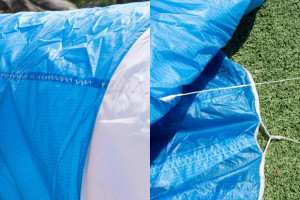 In strong thermals the Artik 4 is very effective; it has a live and adjustable turn and it also keeps a large reserve of speed to close the turns and center the core. It has a sporty character, without being brusque. The performance is very good both for XC and competition.
In strong thermals the Artik 4 is very effective; it has a live and adjustable turn and it also keeps a large reserve of speed to close the turns and center the core. It has a sporty character, without being brusque. The performance is very good both for XC and competition.
In the hands of a good pilot it could fight for the Sport podium without problem. What I liked the most was the use and efficiency of the speed system. You step on to the top, grab the C risers’ handles and with them you control the angle of attack of the wing. The feeling at the C handles is very good; the glider responds smoothly, without noticeable degrade of glide and conveying the pilot a sense of control and security.
The C handles are limited with a not very wide action range, so when things were very bumpy I tried pulling the C risers directly. You have to be precise, but the trick worked well and, particularly in this flight, it allowed me to take advantage of high speeds to advance in areas of descent with clouds.
Sportive turns
The Artik 4 has a sporty turning behavior, between flat and banked, very very effective to climb. The wing keeps high reserves of speed and energy to maneuver it to taste, either to invert the sense, to center the core of the thermal, or to play with the speeds when drifting in strong and narrow thermals.
The risers
They are narrow and robust, with the central “As” in green. They have good Harken pulleys for the speed system, which provides a wide range of speeds. There are handles on the “C” risers for piloting when we step on the speedbar, but the range is narrow. The brake handles are soft, with magnetic clips and swivels.
Top glide
A modern and competitive EN C wing with a relatively moderate aspect ratio of 6.1 (4.6 projected), the Artik 4 sits among the best performing Sport class gliders, with a maximum glide of around 11 points.
Flying accelerated is a pleasure as the Artik 4 has an effective and generous speed system, and it can be efficiently handled with the C-risers controls. If you step on the bar to the top you can reach 58 Km/h and it is quite easy to go on a glide at speeds over 50 Km/h. The best of it is that the wing keeps a high level of security, good internal pressure, and low-stress for the pilot.
Conclusion: Accessible performance. The Artik 4 joins nobility and top performance. This paraglider is easy to fly and has a sporty handling, but keeps the gentleness and solidity of its EN C level.
Construction and finishes
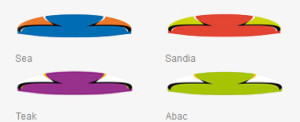
The Artik 4 is available in 5 sizes covering weights from 60 up to 126 kg. It is a glider with a moderate weight of 5.6 kg for size 27. Its construction incorporates the main technologies from Niviuk to improve security and performance: RAM Air Intake technology arranges the internal configuration of the cell
openings to improve internal pressure and the laminar flow of the outer sail, helping improve the absorption of turbulence. The SLE or Structured Leading Edge helps to keep high speeds and to absorb the turbulence with flexibility, without adding weight due to less use of Mylar in the profiles. DRS, Niviuk’s mini-ribs in the trailing edge, are designed to improve the pressure in the trailing edge in order to optimize the turning behaviour.
The sail is made with a combination of tissues. Porcher IND is used for the outer sail, diagonals and profiles. The inner sail uses Dominico TEX. It also has various reinforcements in Mylar and load tapes.
Hybrid lines (different diameters) are optimized 2/3/2 of Liros and Cousin.


